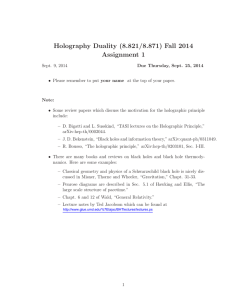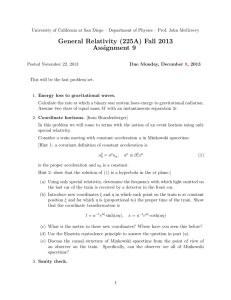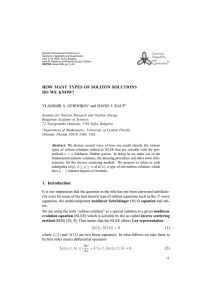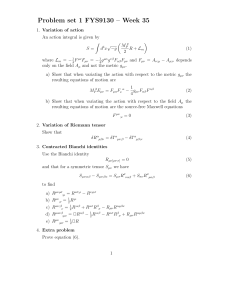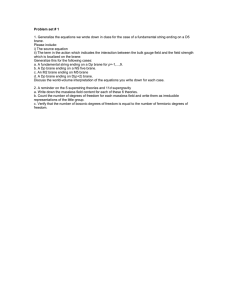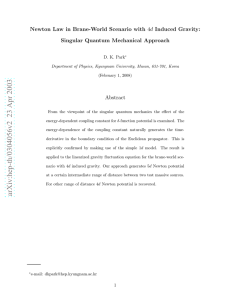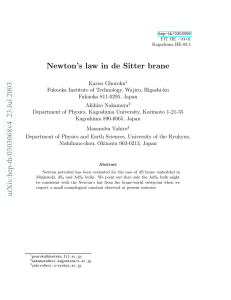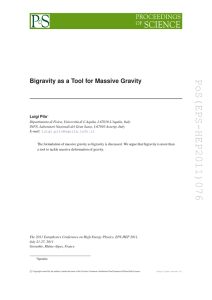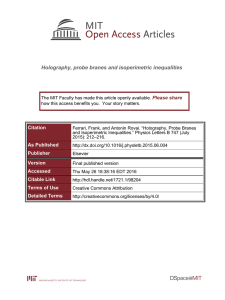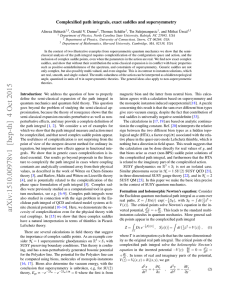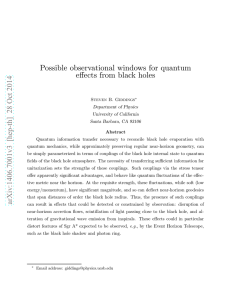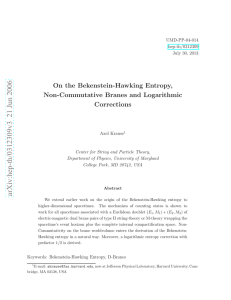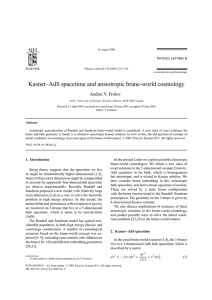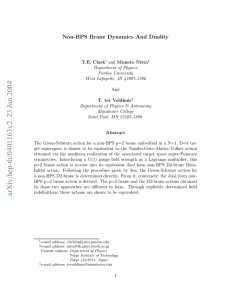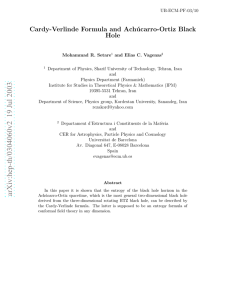MASSACHUSETTS INSTITUTE OF TECHNOLOGY Department of Physics
advertisement
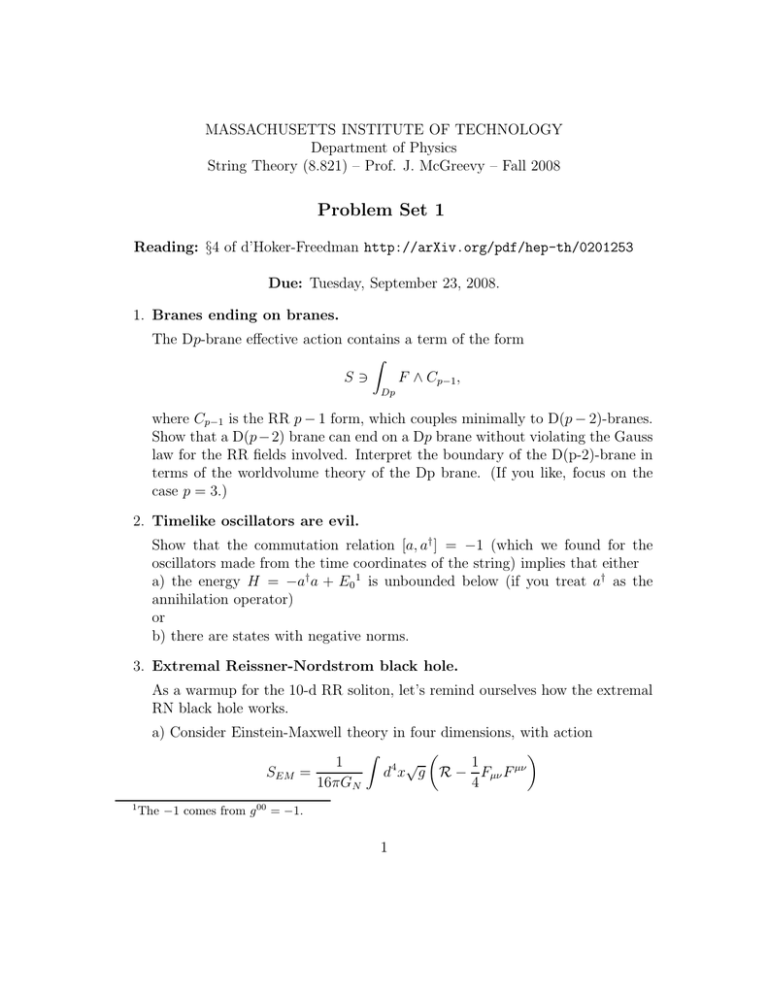
MASSACHUSETTS INSTITUTE OF TECHNOLOGY Department of Physics String Theory (8.821) – Prof. J. McGreevy – Fall 2008 Problem Set 1 Reading: §4 of d’Hoker-Freedman http://arXiv.org/pdf/hep-th/0201253 Due: Tuesday, September 23, 2008. 1. Branes ending on branes. The Dp-brane effective action contains a term of the form Z S∋ F ∧ Cp−1, Dp where Cp−1 is the RR p − 1 form, which couples minimally to D(p − 2)-branes. Show that a D(p − 2) brane can end on a Dp brane without violating the Gauss law for the RR fields involved. Interpret the boundary of the D(p-2)-brane in terms of the worldvolume theory of the Dp brane. (If you like, focus on the case p = 3.) 2. Timelike oscillators are evil. Show that the commutation relation [a, a† ] = −1 (which we found for the oscillators made from the time coordinates of the string) implies that either a) the energy H = −a† a + E0 1 is unbounded below (if you treat a† as the annihilation operator) or b) there are states with negative norms. 3. Extremal Reissner-Nordstrom black hole. As a warmup for the 10-d RR soliton, let’s remind ourselves how the extremal RN black hole works. a) Consider Einstein-Maxwell theory in four dimensions, with action Z 1 1 4 √ µν d x g R − Fµν F SEM = 16πGN 4 1 The −1 comes from g 00 = −1. 1 EM implies that Show that the Einstein equation 0 = δS δg µν 1 2 . Rµν = aGN 2Fµ. Fν − gµν F 2 for some constant a. b) Consider the ansatz ds2 = H −2 (ρ) −dt2 + H 2 (ρ) dρ2 + ρ2 dΩ22 , F = bdt ∧ d H(ρ)−1 EM where b is some constant. Show that the Einstein equation 0 = δS and δg µν δSEM Maxwell’s equation 0 = δAµ are solved by the ansatz if H is a harmonic function on the IR3 whose metric is γab dxa dxb := dρ2 + ρ2 dΩ22 . √ Recall that H is harmonic iff 0 = H = √1γ ∂a ( γγ ab ∂b H). c) Find the form of the harmonic function which gives a spherically symmetric solution; fix the two integration constants by demanding that i) the spacetime is asymptotically flat and ii) the black hole has charge Q, meaning R ⋆F = Q. S 2 at f ixed ρ d) Take the near-horizon limit. Show that the geometry is AdS2 × S 2 . Determine the relationship between the size of the throat and the charge of the hole. [If you get stuck on this problem, see Appendix F of Kiritsis’ book.] d) If you’re feeling brave, add some magnetic charge to the black hole. You will need to change the form of the gauge field to F = bdt ∧ dH(ρ) + G(ρ)Ω2 where Ω2 is the area 2-form on the sphere, and G is some function. 4. RR soliton. In this problem we’re going to check that the RR soliton is a solution of the equations of motion. The action for type IIB supergravity, when only the metric and the RR 5-form and possibly the dilaton are nontrivial can be written as Z 1 1 5 5 ..... 10 √ −2Φ µ d x g e + ... SIIB = (R + 4∂µ Φ∂ Φ) − F..... F 16πGN 5! 2 (The self-duality constraint F 5 = ⋆F 5 must be imposed as a constraint, and means that dF 5 = 0 implies the equations of motion for F 5 .) By the way, this is the action for the string frame metric. a) Show that the equations of motion from this action imply 1 5 2 5 5 .... 2Φ 5Fµ.... Fν − gµν (F ) Rµν = aGN e 2 for some constant a. b) Plug the following ansatz into the equations of motion: ds2 = p 1 H(r) ηµν dxµ dxν + p H(r)dy 2 F = b(1 + ⋆)dt ∧ dx1 ∧ dx2 ∧ dx3 ∧ dH −1 Φ = φ0 (b, φ0 are constants.) Determine the constant b and the condition on the function H for this to solve the equations of motion. To do this, there are two options – some kind of symbolic algebra program like Mathematica or Maple, or index-shuffling by hand. The latter is much more easily done using ‘tetrad’ or ‘vielbein’ methods. I always forget these and have to relearn them every time. For a lightning review of the vielbein method of computing curvatures, I recommend d’Hoker-Freedman http://arXiv.org/pdf/hep-th/0201253, pages 100-101, or Argurio http://arXiv.org/pdf/hep-th/9807171, Appendix C. To help with the former option, I’ve posted an example curvature calculation in Mathematica on the pset webpage. Note, by the way, that for values of p other than 3, the dilaton is not constant. With hindsight, this specialness of p = 3 is related to the fact that this is the critical dimension for YM theory, where gY M is dimensionless. 3


